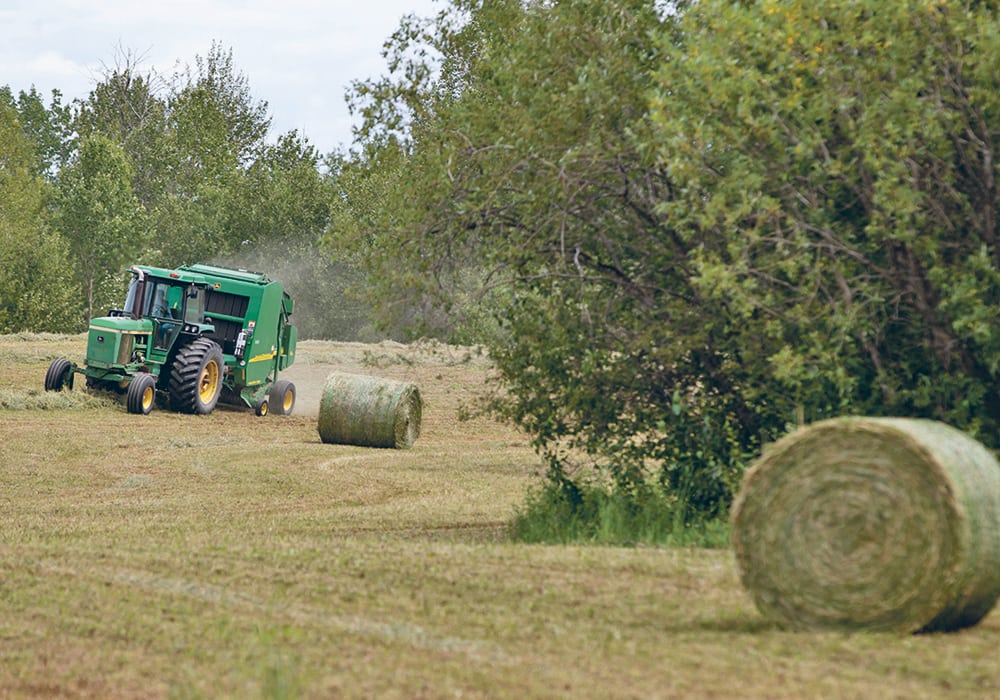FRIEDENSFELD, Man. — The leaves of plants, not surprisingly, are more nutritious than plant stems.
Research indicates that the relative forage quality (RFQ) of alfalfa leaves is 551, compared to an RFQ of 70 to 80 for alfalfa stems, said Dan Undersander, a University of Wisconsin forage specialist.
The relative feed value, another measurement of hay quality, tells a similar story. The RFV of alfalfa stems is 80 to 100, while alfalfa leaves have an RFV of 480.
The message in those numbers is simple: a forage with more leaves will be higher quality.
Read Also

Farming Smarter receives financial boost from Alberta government for potato research
Farming Smarter near Lethbridge got a boost to its research equipment, thanks to the Alberta government’s increase in funding for research associations.
“It’s really important for us to think about how we (treat) our leaves during the harvesting process,” said Undersander, who spoke via phone to producers attending Manitoba Hay Day, held in late June in Friedensfeld, Man.
“Leaf loss is far more important than I ever would have thought.”
During his presentation, Undersander said U of W researchers collected hundreds of hay samples from three different states and measured the amount of leaves relative to stems in the forage.
“Seventy-two percent of the change in forage quality was due to leaf content,” he said. “Seventy-two percent. Leaf content was more important than maturity.”
Leaf content is critical because leaves have two to four times the crude protein concentration and less fibre than stems.
Since leaf content is essential for hay quality, Undersander was curious about leaf losses during the harvest process.
Most alfalfa fields are about 50 percent leaves and 50 percent stems, plus or minus five percent.
But the ratio of leaves to stems can drop dramatically because leaves can drop or shake off from cutting, raking and baling.
“The key thing is to look at what percentage of leaves that end up in your final harvested hay,” he said.
To answer that question, Undersander looked at data from three states, where an intern with Winfield, an ag consultancy, took hay samples during the various stages of harvest and measured the amount of leaves in the forage.
In one case, the percentage of leaves in the hay was about 45 percent when the crop was standing. After cutting, the percentage dropped to 43 percent and when the crop was harvested and chopped for haylage, the final percentage of leaves was 32 percent.
The loss of leaves affected forage quality and quantity because fewer leaves on the plants reduced the volume.
“We lost 16 percent (of yield) when we chopped this alfalfa,” Undersander said. “I think there’s more of that going on than we realize.”
Overall, data from three states showed that alfalfa lost about nine percent of its leaves on average, from standing until harvest.
In some cases, the losses were much higher because a number of producers had forage with 30 percent leaves and 70 percent stems.
“We’re seeing a lot of samples come in (at) 30 percent leaf … when we know we started at 50-50,” Undersander said.
“Do analyze your situation. If your hay isn’t as leafy as you’d like it to be, I urge you to try and figure out why not.”
There are ways to reduce leaf loss when harvesting hay:
- Look on the ground for leaf loss. If there are leaves on the soil before harvest, it may be a sign of a leaf disease and a need to spray the alfalfa with a fungicide.
- Rake at about 40 to 50 percent moisture. If raked when too dry, the rake will shake off leaves.
- Move the hay as little as possible. “Every time you move the hay, you’re going to lose leaves,” Undersander said. “You’re going to lose dry matter and you’re going to lose quality.”
- Consider a rotary rake. “In the study that we did, in three states … we found that a rotary rake and a merger had the highest leaf content.”
- Bale hay at 15 to 18 percent moisture for round bales. “Hay moisture content is the most important factor when it comes to leaf loss,” Alberta Agriculture states on its website. “Baling too dry can cause higher pick-up and bale chamber losses than baling at the correct moisture level.”


















